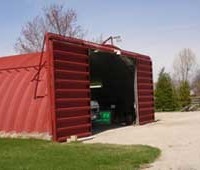Aside from winterizing the plumbing system, when an RV is stored in Ohio or other cold weather states there are several other areas that should be prepared for winter.
- Coolant/Antifreeze: Any RV with an engine or water cooled generator should have the antifreeze tested before freezing temperatures set in. Antifreeze should be tested for freeze point, reserve alkalinity, and PH level. This test can easily be done with coolant test strips available at your local auto parts store.
- Oil Change: I prefer to store my Motorhomes with clean oil in them. In some cases, acids exist in contaminated oil and can cause internal problems in engines. I recommend clean oil, a clean oil filter, and chassis lubrication prior to winter storage. Along with chassis lubrication, be certain to check and fill all fluids so your RV will be ready for use after storage.
- Tires: Check the air and fill the tires to their recommended pressure. Follow the manufacturers recommended pressures from the label located inside your RV or the owner’s manual. Apply a tire protectant to the tires. There are many available. Read the labels and choose one that will block harmful UV rays and keep the tires from drying out.
- Roof: Carefully inspect the roof for any leaks or damage. Caulk or seal any problem areas. Be certain all vents are in good condition and not leaking.
- Propane: I recommend turning off propane tanks at the shut off valve. Check the shut off valve with leak detector or soapy water to be certain it is not leaking in the off position. If the shut off valve is leaking, have it replaced by a professional before storage.
- Batteries: Batteries need proper maintenance. Check and fill the electrolyte to the proper level before storage. There are some options to avoid battery freeze. Batteries will not freeze if properly charged. It is important to reach a balance with battery charge. Batteries can be damaged by overcharging as well. I recommend not leaving the shore power cord connected to electricity for extended periods (winter storage). The converter/charger will overcharge the batteries and the batteries be ruined. With easy access to the RV, the shore power cord can be connected to electricity in cycles. On for 2 weeks then off for 2 weeks. Another option with limited or no access to the RV is to disconnect the batteries. Before disconnecting, be certain the batteries are fully charged. If the batteries cannot be charged before storage, I recommend removing them and storing them in a non freezing environment. Be careful to follow proper battery safety. Flooded batteries can be dangerous. Do not store them near any combustible device.
- Fuel Stabilizer: Add the proper amount of fuel stabilizer to any gasoline or diesel tank. Be certain to run the engine to distribute the stabilizer before storage. Small amounts of fuel turn bad quickly, therefore I recommend having tanks nearly full for storage. Carbureted generators tend to have fuel problems after storage due to the small amount of fuel in the carburetor float bowl. Some carburetors have a drain screw in the float bowl. I recommend draining the float bowl if there is easy access. Check your owners manual.
- Rodents: Rodents can be a problem for RVs. There are several methods I use during storage to prevent rodent damage. Seal all areas where wires and lines go through the RV from outside to inside. Expanding foam sealer works well. Remove all food from the RV. Remove anything sweet and anything fragrant. Place moth balls inside and around the outside if stored inside. Do not place moth balls directly on any surface inside your RV. Use small foil containers so the moth balls will not melt into carpets or fabrics. Set traps and check them often. I set traps in compartments and inside all my RV’s during the cold weather. I check them at least once a week.
After you have completed part 1 & 2 of my guide to winterization you should be well prepared for winter.
If you want Wilson RV to winterize your RV call 419-529-2700 ext 2 to make your appointment today.

[…] How to Winterize your RV part 2 […]